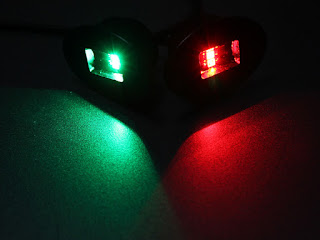Basic Marine Navigation Lighting
Recently, I read an article about another boating
accident. This one occurred at night and
the two boats involved in the incident apparently collided head on. When I hear about incidents such as this, I
often wonder how it happened. Was
someone operating a boat under the influence of alcohol or drugs? Was someone just not paying attention? In the case of this most recent incident, one
of the boats involved apparently did not have any navigation lights on. The incident resulted in at least three
individuals losing their lives. None of
the passengers on either vessel were wearing life jackets. We often hear safety reminders about wearing
life jackets and boating under the influence but what about navigation lights?
There are a lot of boaters that do not boat at night and
therefore, never use their navigation lights.
As a result, many of us never give a thought to maintenance and some of
us don’t even know what they mean when they are observed out on the water. There are a lot of variations for marine
navigational lighting based on the size and type of boat but for the purpose of
this discussion, I am going to focus on what you would typically see on
recreational boats.
Your typical recreational vessel (those less than 65 feet)
will have a red light that can be seen from directly in front of the vessel
around to 112.5 degrees to the port side.
There will also be a green light that can be seen from directly in front
of the vessel around to 112.5 degrees to the starboard side. If you think about it, these lights
correspond to the navigational rules. If
you are on a potential collision course with another vessel and you see its
green navigational light, then you are the stand on vessel and can maintain
course and speed. On the other hand, if
you see the red light of the other vessel, then you are required to change
course and/or speed to avoid a collision.
If you see both the red and green lights then the other vessel is
heading straight for you.
In addition to the green and red lights, each vessel will
have a white light. Depending on the
vessel size and type, it may be a single 360 degree light (typically vessels
less than 39 feet) or it may be two lights with one facing aft (stern light) in
a 135 degree arc and the other facing forward (masthead light) in a 235 degree
arc (typically vessels over 35 feet).
When underway, this ensures that a vessel can be seen from astern and
also serves as a method of establishing
orientation of the vessel when viewed along with the red and green
lights from the side or front. When at
anchor, a vessel should display only a 360 degree white light and no red or
green lights. Displaying full navigation
lights when at anchor can be a dangerous situation as other vessels in the area
may falsely assume that you are underway and that you can make changes in
course and/or speed to avoid a collision.
 |
This is how a boat with a 360 degree while light would look at night.
|
A Few Tips
LED Lights - If
your navigation lights are not already LED, consider replacing the existing
ones with LED lights. They use less
power and will last practically the life of your boat. This is really helpful if you are not
diligent in checking your lights before heading out on the water.
Accent Lighting -
In most areas, it is okay to display additional lighting on your boat such as
underwater lighting or accent lighting provided the following applies:
1.
The
additional lighting must not interfere with another vessels ability to properly
interpret your navigation lights.
2.
The additional lighting must not create the
potential to cause the vessel to be mistakenly identified as a law enforcement
or rescue vessel.
3.
The additional lighting must not be bright enough
as to blind operators of other vessels at night.
When to use
Navigation Lights – If you are out on the water, you should use your
navigation/anchor lights starting at dusk and continue use until dawn. Navigation lights should also be used during
periods of reduced visibility such as when it is foggy or raining.
Sail Boats –
Navigation lights on sailboats can be a bit different than powerboats. If a sailboat is under sail, it should not
display a forward white masthead light.
If it is under power, it should display the forward masthead light. Sometimes this light is also called a
steaming light. It comes from the old
days because it was used to differentiate if the vessel was under steam power
or not. Don’t forget that boats under
sail have the right of way over power boats at all times (This applies to a recreational powerboat when it encounters a recreational sailboat. The rules sometimes change when other types of vessels come into play). If a sailboat has its engine(s) running and
propeller engaged, it is considered a powerboat.
Happy Boating
Captain Frank
Visit our archive and check out more interesting articles from The Ship's Log by clicking here.
If you found this article useful, use the space below to subscribe and you will be notified by email every time a new article is published in The Ships Log. Don't forget to check your email afterwards for a subscription verification email from Feedburner. Your email address will only be used for notifying you when updates are made to The Ships Log.







LEDAdvantage's Boat LED Navigation Lights offer reliable and energy-efficient solutions for safe marine navigation.
ReplyDelete